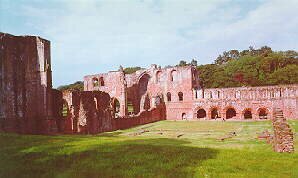THE EDGE
VACATION & HOLIDAY GUIDE TO
CUMBRIA & THE LAKE DISTRICT
Furness Abbey Cumbria

THE EDGE VACATION & HOLIDAY GUIDE TO CUMBRIA & THE LAKE DISTRICT Furness Abbey Cumbria |
|---|

|
|
Location: OS ref SD 218718 Sheet 96. In the SW of the County. Nearest Town: Barrow in Furness The Abbey is on the out skirts of the town. Off the A590.
|
Founded by the Savigny monks of Normandy in 1127 by 1150 Furness Abbey was in the hands of the Cistercians who were better established in the area. Furness was older than the Cistercian centre at Waverley Abbey and there was some dispute as to which was to take precedence. Waverley took the honour. The Savingy monks resisted the absorption of their order by the Cistercians but had to accept defeat.
Furness Abbey even its now ruined state is an impressive building, illustrating the importance of the Abbey in the area and its own wealth. The Abbey had extensive interests in land locally and also in the Lake District, the County of Yorkshire, in Ireland and the Isle of Man. The connections with Ireland and the Isle of Man developed when the harbour of Piel was built. Iron was found in the area and this, together with wool and meat from sheep farming and ample supplies of timber, did much for the Abbey's well-being. During this time of increased prosperity the Abbey began to increase its influence by developing other monasteries and convents in Cumbria, Yorkshire Ireland and the Isle of Man, all in the early 1200's. Raids by the Scots had caused little trouble until 1316 when the Abbey suffered as badly as the rest of Cumbria. It is possible that this raid or another equally brutal led by Robert Bruce in 1322 gave the impetus to build Dalton Castle not far to the north, in order to provide some defence for the Furness Peninsula and the Abbey. The raid of 1322 and the sacking of Holme Cultram monastery further to the north decided the Abbot of Furness to attempt to placate Robert Bruce and a ransom (= protection money) was paid to him. This attempt at appeasement didn't work. The Abbey's land and property were pillaged and burnt and Scottish raids continued sporadically until about 1346. Piel Island in the middle of the entrance to Barrow Harbour had been the property of the Abbot and in 1411 the castle was returned to the Abbey and rebuilt. At the Dissolution in 1537 the Abbey was taken over by the Crown. The lead was removed from the roof and the buildings plundered for stone. Over the next 400 years the Abbey ruins were owned by several different families. At some point a large manor house was built which enjoyed a period of prosperity as an hotel when the railway to Barrow-in-Furness passed close by. It is now a restaurant, but is not in its original state having been largely redeveloped in the 1950's. Furness Abbey has been in the care of English Heritage and its predecessor since 1923. There is a small museum and shop.
|
|
Religious Buildings |
History Index |
Main Index |
Next Building |
Copyright © EDGE 1997